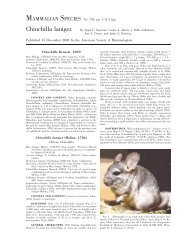Brugia Malayi - Clark Science Center - Smith College
Brugia Malayi - Clark Science Center - Smith College
Brugia Malayi - Clark Science Center - Smith College
You also want an ePaper? Increase the reach of your titles
YUMPU automatically turns print PDFs into web optimized ePapers that Google loves.
Developing and Evaluating a Monthly Curve Number Method for<br />
Predicting Stormflow<br />
Kate Meyer and Julia Signell<br />
When rain falls on any surface, some is caught by the tree canopy, some infiltrates into the soil, and some runs off overland.<br />
The portion that flows overland reaches the stream shortly after hitting the ground, so this water is called stormflow. Predicting<br />
stormflow is an essential tool for addressing hydrologic problems such as flood forecasting, sedimentation, and nutrient loading.<br />
Over the past few decades the Natural Resources Conservation Service’s Curve Number method has become one of the most<br />
widely used tools for predicting stormflow. This method uses antecedent wetness conditions, soil type, and land use information to<br />
assign Curve Numbers (CN) to watersheds. With a simple equation, CN and daily precipitation data can predict stormflow. 1<br />
The simplicity of this method is appealing, unfortunately the CN method was designed for a daily time step and sometimes<br />
precipitation data are only available by month. Using the assumption that the depth of rainfall behaves exponentially, we modified<br />
the CN method to allow for monthly precipitation data. With this adaptation, the user can predict stormflow for a basin knowing<br />
only total monthly precipitation, CN, and the number of storms each month.<br />
We evaluated this tool by comparing the measured stormflow (‘observed stormflow’) to three different predicted stormflows.<br />
We calculated one of the predicted stormflows by assuming that all of the storms in any given month had the same depth of<br />
precipitation (‘simulated monthly mean’). We calculated the other two predicted stormflows using the new tool (‘simulated monthly<br />
ex.’), and the standard daily CN method (‘simulated daily’). We compared the observed and predicted stormflows using two<br />
different statistical measures. The coefficient of variation of the root mean squared error, CV(RMSE), measures how well the<br />
graphs of predicted and observed stormflow match in shape. The annual percent error (APE) measures how well the predicted<br />
total runoff for the year matches observed. We ran these tests at four USGS sites where we were able to calculate a meaningful<br />
CN.<br />
We determined that, except for a slight discrepancy at Curlew Creek in the CV(RMSE), daily works best, then exponential,<br />
then mean. This suggests that our modification works fairly well and certainly better than simply using the average. Given the<br />
exciting first findings of this monthly CN method, a possible avenue of future research might be to find and assess more sites<br />
in varying climates across the United States or the world. (Supported by the Gordon and Betty Moore Foundation, Stanford<br />
University and the Stephen Bechtel Fund, CEEDS)<br />
Advisor: Andrew Guswa<br />
References:<br />
1<br />
Dingman, S. Lawrence. Physical Hydrology. 2 nd edition. Long Grove, IL: Waveland Press Inc. 2008, 445-450.<br />
2012<br />
109

















